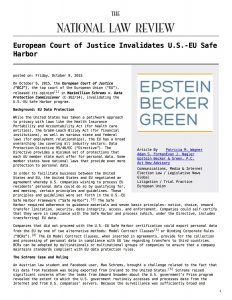On October 6, 2015, the European Court of Justice (“ECJ”) invalidated the Safe Harbor program in its opinion in Maximilian Schrems v. Data Protection Commissioner.
Safe Harbor Overview
Safe Harbor was a program designed to allow the exchange of personally identifiable information (“PII”) between the U.S. and EU, and was developed in 2000, according to a VentureBeat article. Safe Harbor was supposed to address EU regulations which mandated that a certain minimum level of privacy protections must be in place before PII regarding EU citizens could be transferred out of the EU, VentureBeat reports. This VentureBeat article indicates that under Safe Harbor, U.S. companies could “self-certify” that they met the EU standards to allow data transfers. According to the National Law Review, Safe Harbor contained seven guiding principles for the privacy and protection of EU data:
- Notice;
- Choice;
- Onward Transfer Limitation;
- Security;
- Data Integrity;
- Access; and
- Enforcement.
The VentureBeat article points out that Safe Harbor has been a hot button topic since it was first instantiated and this was further exacerbated following the Edward Snowden revelations about the NSA’s PRISM surveillance program (in 2013).
Safe Harbor Court Challenge
An Austrian privacy advocate, Maximilian Schrems raised a challenge to Safe Harbor arguing that the U.S., and specifically Facebook, had insufficient protections for PII of EU citizens, according to the article. The article states that Schrems’ case started with the Irish Data Protection Commission (“IPDC”) which held that Facebook was covered under Safe Harbor. However, Schrems contested that finding and the case went to the ECJ, according to the court opinion. In a 27 page ruling, the ECJ held that the Safe Harbor agreement does not guarantee that U.S. entities have privacy protection measures that meet EU standards, in large part due to the fact that U.S. Law enforcement and intelligence agencies are not bound by the Safe Harbor provisions, according to VentureBeat.
A Post-Safe Harbor World
According to the VentureBeat article, over 5,000 companies relied on Safe Harbor to allow the transfer of EU data to U.S. servers. The article states that the ECJ ruling doesn’t require EU-U.S. data transfers to halt immediately, but rather, gives EU regulators the right to oversee and suspend any transfers which they feel lack the requisite protections.

The National Law Review recently released an article that provides guidance for U.S. companies following the ECJ Ruling.
- Use Binding Corporate Rules (“BCR”) or Model Contract Clauses
- U.S. companies can use this approach to tailor agreements to institute privacy policies that will satisfy the EU,
- caveat: due to Upstream data collection and PRISM, the EU may still rule these invalid.
- Strengthen Privacy Policies
- Companies can take steps to strengthen their overall privacy protections,
- companies can also exert influence on Congress to pass legislation that includes data and privacy protection safeguards.
- Wait and See
- The EU has been working on new regulations, General Data Protection Regulation (GPDR), which the EU hopes to adopt by the end of 2015,
- it is possible that the EU will fill the gap created by the Safe Harbor invalidation in the new GPDR.
- Discontinue all Data Transfers from the EU to the U.S.
- From a global business perspective this is highly unlikely, however it is a means by which companies can become immediately compliant with the ECJ ruling,
- However, given the technical infrastructure currently in place within and between many business entities, some businesses may not even be able to halt these transfers in the short-term.
According to the National Law Review article.
My opinion:
In reality, under the Foreign Intelligence Surveillance Act (“FISA”) Section 702 as amended in 2008, the interests of National Security trumps any data protection or data privacy safeguards. Under 702, the Attorney General and the Director of National Intelligence merely have to go before a FISA court to authorize the policies and procedures for data collection. Under 702 FISA, data collection is not targeted at a specific person and therefore the FISA court does not rule at that level of granularity, there is simply a broad ruling which allows data collection to move forward. Consequently, as long as 702 FISA in its current incarnation exists, the U.S. cannot guarantee data privacy and protection for its own citizens, let alone EU citizens. Therefore, while the EU and US may develop a new agreement as a replacement for safe harbor, it can be circumvented. Unless U.S. legislation radically modifies U.S. intelligence operations, EU data will simply not have the same safeguards and protections in the US as the data purportedly has in the EU. However, in the interest of facilitating a global economy and continued business operations, it seems likely that some agreement will be put together to enable EU-U.S. data transfer to continue, irrespective of the actual impact to EU PII.







Leave a Reply